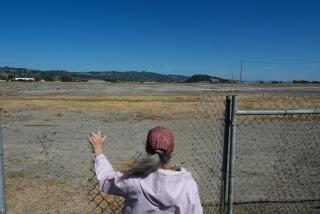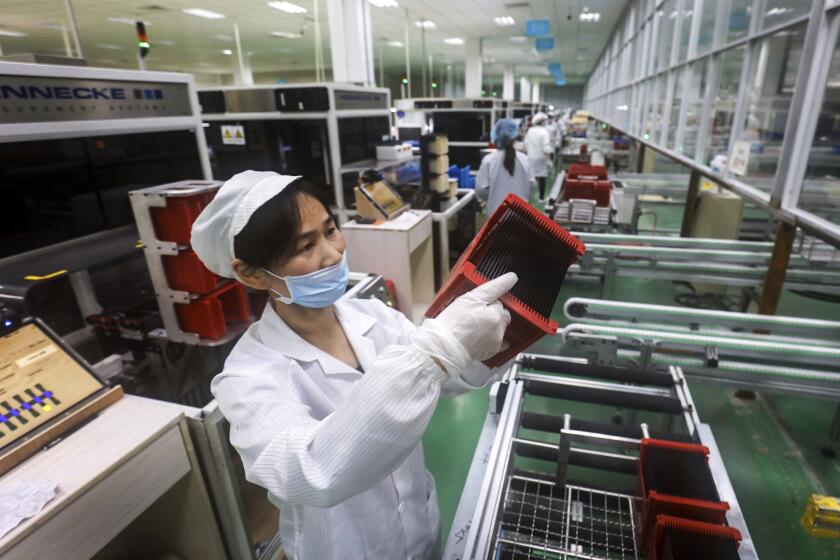Japan’s nuclear cleanup
- Share via
The nuclear crisis in Japan is far from over. In recent days, highly radioactive water has been discovered in tunnels under reactors at the Fukushima Daiichi plant, and radioactive plutonium has been found in the soil nearby. Efforts to contain the leaking radioactive material are underway, and cleanup will take far longer. Here are answers to some basic questions.
How did plutonium get into the soil?
In two samples, tests suggest that the plutonium came from the Fukushima reactors. If that is the case, it probably was released into the air and then settled on the ground.
Other positive tests probably were measuring plutonium that was already in the soil. Nuclear weapons testing by the U.S. and the Soviet Union from 1945 to 1962 spread low levels of radioactive plutonium around the world, said John Boice, a cancer epidemiologist and radiation safety expert at Vanderbilt University in Nashville.
Also, the bomb dropped on Nagasaki by the U.S. in 1945 was made with plutonium, and trace quantities of that fallout could still be present in Japanese soil.
I thought nuclear power stations used uranium as fuel.
Most do. But some fuel is enriched with plutonium, as is the case with reactor No. 3 at Fukushima. The soil contamination could indicate a breach in the containment vessel surrounding the reactor core. It
is also possible that the plutonium came from another reactor. When uranium fuel is bombarded with neutrons, the atoms usually split, a process that releases energy. But in some cases, neutrons are absorbed, turning uranium into plutonium.
How dangerous is plutonium?
Plutonium is extremely carcinogenic even at low doses when it is ingested or inhaled. During the Cold War, Soviet Union workers helping develop nuclear bombs wound up swallowing and inhaling large amounts. They suffered high rates of lung, liver and bone cancers.
That said, the concentrations reported in the soil around Fukushima are far below international standards for what is considered dangerous for adults and even for infants, said Andrew Maidment, an associate professor of radiology at the University of Pennsylvania in Philadelphia. At this point at the Fukushima plant, a person would have to eat a lot of dirt to be at risk.
Does the danger decline with time?
Not in our time. Plutonium-239, one of the most common plutonium isotopes, has a half-life of 24,000 years, meaning it would be more than 200,000 years before it largely disintegrated into harmless byproducts, far longer than for radioactive iodine or cesium, the more abundant types of contamination.
The good news: Plutonium is heavy, so the most significant concentrations aren’t likely to drift very far.
Could the contamination level ever approach that at Chernobyl?
No way, experts say. The damaged reactor at Chernobyl did not have a containment vessel. In the 1986 accident, radiation was released in an explosion and weeklong fire that spread radioactive debris over a large swath of the region. The disaster spurred a cleanup involving 500,000 workers and still required the permanent resettlement of villages in Ukraine and Belarus.
Fukushima, in contrast, is leaking radioactivity.
What will workers do to clean up the radioactive water?
Over the short term, they won’t be able to do much. “You move people out of the way, and then you take stock,” said Thomas McKone, a professor of environmental health sciences at UC Berkeley.
But once the situation is stabilized, plant operators probably will pump the contaminated water out of the reactor buildings to an area where it can be “scrubbed,” or cleaned through processes such as filtering or adding chemicals to separate out radioactive solids.
Depending on how much radioactivity remains in the water after scrubbing, it may be stored in holding ponds to allow remaining radioactive atoms to decay, said Travis Glenn, an environmental health science professor at the University of Georgia in Athens. Any solid waste that results from the cleaning process may be treated further, and eventually will be stored away too. Dumping highly radioactive water into the ocean is not permitted by international law.
How about the contaminated soil?
That can be cleaned up too, though how engineers go about it will depend on how much and what kind of radioactive material is found in various locations. In “hotspot areas” of high radioactivity, Glenn said, workers may dig up contaminated soil, move it and bury it.
In places where radiation levels are lower, which probably will be most if not all of the site, they’re more likely to let contaminated soil decay in place or put additives in the soil that bind with radioactive materials to prevent them from washing away or getting absorbed by plants. For example, McKone said, the U.S. government added potassium salts to soil near nuclear testing sites in the Marshall Islands in Micronesia to prevent plants there from absorbing radioactive cesium from the soil.
When will the cleanup process start?
Certainly not right away. “I don’t think they know yet exactly what they have,” McKone said. “And figuring that out is a lot of work. It’s a long, tedious process.”
alan.zarembo@latimes.com
More to Read
Sign up for Essential California
The most important California stories and recommendations in your inbox every morning.
You may occasionally receive promotional content from the Los Angeles Times.












